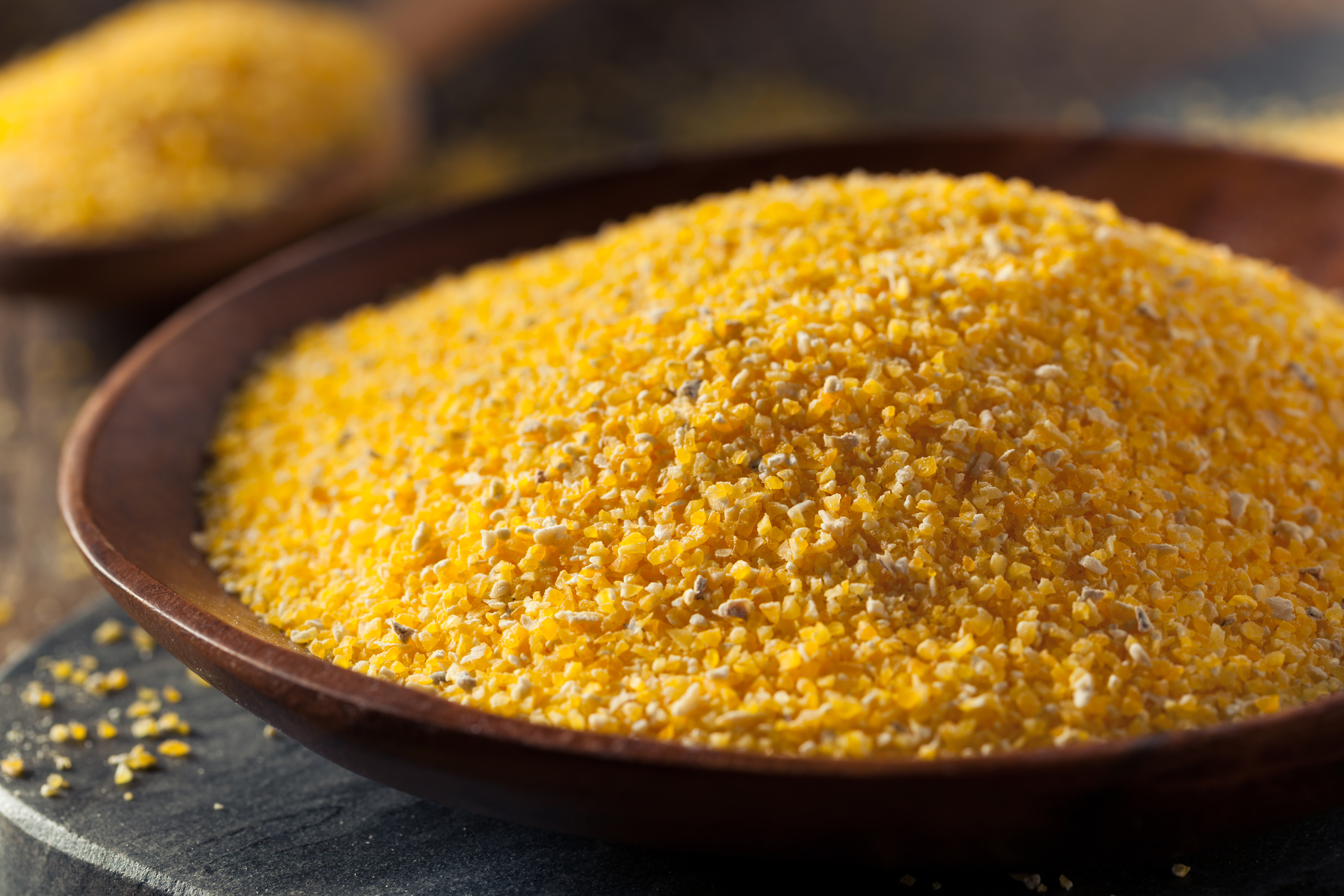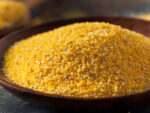
Cooking with Indian Meal (Corn Meal)
In cookbooks from the 1800s, corn meal was called Indian corn (maize). Corn was native to America (U.S.), and was used for many recipes. In Great Britain, however, Indian corn was considered only fit for feeding animals.
INFORMATION BELOW FROM 1800s COOKBOOKS
CORN CAKE
Take a pint of sour milk or buttermilk, break an egg into it, stir in a spoon or two of flour, and add Indian meal enough to make a thick batter. Put in a teaspoon of salt, stir it five or six minutes, and then add a heaping teaspoon of saleratus* (sodium bicarbonate / baking soda) dissolved in hot water. If it is the season for berries of any kind, put in a gill* or two. Bake in a pan or on the griddle.
*saleratus – sodium bicarbonate (or sometimes potassium bicarbonate) as the main ingredient of baking powder.
*gill or jill – a liquid measurement; four ounces in the U.S. and five ounces in the U.K.
CORN CAKE No. 2
Take a pint of sweet milk, half a gill of yeast, one gill of flour, a teaspoon of salt, and half a teaspoon of saleratus. Stir in Indian meal enough to make it rather stiffer than griddle cakes. Let it rise overnight and in the morning, bake twenty-five minutes in two shallow pans, or thirty-five in a deep one. This kind of cake has the advantage over those made without yeast. If a piece of it is left, it is not heavy when cold, but is as palatable a lunch as a slice of good bread.
JOURNEY OR JOHNNY CAKES
Scald a quart of sifted Indian meal with sufficient water to make it a very thick batter. Stir in two or three teaspoons of salt. Mold it with the hand into small cakes. In order to mold them up, it will be necessary to rub a good deal of flour on the hands to prevent their sticking. Fry them in fat nearly enough to cover them. When brown on the under side, they should be turned. It takes about twenty minutes to cook them. When cooked, split and butter them.
JOURNEY OR JOHNNY CAKES No. 2
Scald a quart of sifted Indian meal and put in saleratus dissolved in milk and salt, in the proportion of a teaspoon of each to a quart of meal. Add three tablespoons of wheat flour and drop the batter by large spoonfuls into a frying pan. The batter should be a very thick consistency and there should be just fat enough in the frying pan to prevent the cakes sticking to it.
EGG PONE
Beat three eggs very light and mix them with a half-pint of milk. Then stir in gradually, a quart of Indian meal, adding one teaspoon salt and a tablespoon of butter. It must not be a batter, but a soft dough, just thick enough to be stirred well with a spoon. If too thin, add more Indian meal; if too stiff, thin it with a little more milk. Beat or stir it long and hard. Butter a tin or iron pan. Put the mixture into it and set the pan immediately into an oven, which must be moderately hot at first, and the heat increased afterward. A Dutch oven is best for this purpose. It should bake an hour and a half or two hours, in proportion to its thickness. Send it to the table hot, and cut into slices. Eat it with butter, or molasses.
A FARMER’S INDIAN PUDDING
Before you begin, set over the fire a large pot filled with water, which must boil hard by the time the pudding is mixed. Put the a quart of rich milk* by itself, into another pot or sauce-pan, and give it a boil. When it has come to a boil, pour it into a deep pan and stir into it a pint of the best West India molasses.
Then add, by degrees, three pints of sifted Indian meal, a handful at a time; and lastly, a tablespoon of ground cinnamon or ginger. You may add with the spice the yellow rind of a large lemon or orange, finely grated. Stir the whole very hard.
Have ready a square pudding-cloth. Dip it in boiling water, shake it out, dredge it with flour, and spread it open in a broad pan. Then pour the pudding-batter into the cloth, leaving near one-third vacant as room for it to swell, and tie it firmly with tape. Make a morsel of stiff dough with flour and a little water, and with it stop closely the little aperture at the tying-place, to prevent water from getting in there. Plaster it on well.
Put the pudding into the large pot of boiling water; cover it closely with the lid; and let it boil steadily for at least three hours; four will not be too long. While boiling, turn it frequently. As the water boils away, replenish it with some more water, kept boiling hard for this purpose, in a kettle. On no account pour in cold water, as that will render the pudding heavy. Turn it out of the cloth immediately before it goes to table, and eat it with butter and molasses. It will be found excellent. The West India molasses will make it as light as if it had eggs.
*rich milk – one-fourth to one-third cream.
VERY PLAIN INDIAN DUMPLINGS
Sift some Indian meal into a pan. Add a saltspoon* of salt to each quart of meal, and scald it with sufficient boiling water to make a stiff dough. Pour in the water gradually, stirring as you pour. When the dough becomes a stiff lump, divide it into equal portions. Flour your hands and make it into thick, flat dumplings about as large round as the top of a glass tumbler or a breakfast cup. Dredge the dumplings on all sides with flour, put them into a pot of boiling water (if made sufficiently stiff they need not be tied in cloths,) and keep them boiling hard till thoroughly done. Try them with a fork, which must come out quite clean, and with no clamminess sticking to it.
They are an excellent appendage to salt pork or bacon, serving them up with the meat; or they may be eaten afterwards with butter and molasses, or with milk sweetened well with brown sugar, and flavored with a little ground spice.
*saltspoon – a miniature spoon used with an open salt cellar for individual use before table salt was free-flowing. One saltspoon equals one-fourth teaspoon.
INDIAN PUFFS
Boil a quart of milk. When it has come to a boil, gradually stir into it, eight large tablespoons of Indian meal, four large tablespoons of powdered sugar, and a grated nutmeg. Stir it hard, letting it boil one-fourth hour after all the Indian meal is in. Then take it up and set it to cool.
While cooling, beat eight eggs as light as possible, and stir them, gradually, into the batter when it is quite cold. Butter some teacups,* nearly fill them with the mixture, set them into a moderate oven, and bake them well. Turn them out of the cups and send them to table warm. Eat them with butter and molasses, or with butter, sugar, lemon-juice, and nutmeg stirred to a cream.
*teacup – same as a jill or gill; four ounces in the U.S. and five ounces in the U.K.
Image from Deposit Photos
=================================================
Do You Ever Cook With Corn Meal? Please Leave a Comment Below.
=================================================

3 thoughts on “Cooking with Indian Meal (Corn Meal)”
I love historic recipes, thanks for sharing!
Those Indian puffs sure sound good! So do the corn cakes. I don’t use cornmeal much because I am trying to keep carbs down but I do have some and use it now and then.
I don’t use cornmeal much, either, but I bought some the other day. I want to try recipes with new ingredients.